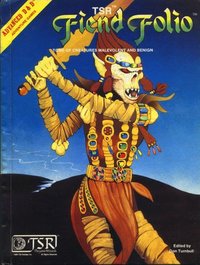Monster Manual
|
|
Monster_Manual_cover-200px.jpg
The Monster Manual is the primary sourcebook for monsters in the Dungeons & Dragons fantasy role-playing game. It includes both monsters derived from mythology and folklore, and creations invented for D&D specifically, describing each with game-specific statistics (such as number of hit dice), a brief description of its habits and habitats, and an image. With the Player's Handbook and Dungeon Master's Guide, it is one of the three "core rulebooks" of the Dungeons & Dragons game.
The original Monster Manual was written by Gary Gygax and published for Advanced Dungeons & Dragons in 1979; two successors, the Monster Manual II and the Fiend Folio, followed thereafter. While the Monster Manual II added many popular monsters to the D&D mythos, there were also some less-than-spectacular monsters such as the modron. The Fiend Folio ran hot and cold with some clangers like the "sheet phantom" and the infamous flumph (one of the only non-evil creatures presented). But it also introduced several popular monsters to the D&D game such as the ubiquitous drow, the githyanki and githzerai, the slaad, and the death knight. Many of the Fiend Folio's contents were culled from the fanzine White Dwarf.
MonsterManual2Cover.jpg
In 1989, Advanced Dungeons & Dragons Second Edition was released, and the Monster Manual was replaced with the Monstrous Compendium. The Compendium was a binder of looseleaf sheets rather than a hardback book. Over twenty supplemental volumes of the Monstrous Compendium series were released. However, the binder format proved unsuitable for the game. The format was intended to help Dungeon Masters keep all of their monster statistics in one place and in alphabetical order, which was undermined by the fact that almost every looseleaf page in the series featured a different monster on each side, making it impossible for DMs to keep monsters in strict alphabetical order. Furthermore, the looseleaf pages had a tendency to tear along the holes for the binder. The binder format eventually was phased out, much to the collective relief of D&D fandom, and the Monstrous Manual was released, compiling all monsters from the first two volumes of the Monstrous Compendium plus a large number of monsters from other sources.
In 2000, Dungeons & Dragons Third Edition was released, and a new Monster Manual was published, updating many monsters to Third Edition rules. Several subsequent monster-specific rulebooks have been published under the Third Edition banner. New books bearing the names Monster Manual II, Monster Manual III, and Fiend Folio were released, though some of the specific monsters featured therein have almost no overlap with those of their First Edition namesakes.
In 2001, Monster Manual won the Origins Award for Best Graphic Design of a Roleplaying Game, Adventure, or Supplement 2000.
Artwork
The pen and ink illustrations within the first volume of the Monster Manual are uneven—some artwork is amateurish (as was all D&D in the early days), while some shows skillful use of lines and media. The cover for the first Monster Manual is perhaps the prime example of poor artwork and is often jokingly disparaged by fans. Despite their uneven quality, some fans regard the illustrations within the tome as some of the best in the series. The credited artists of the first manual were David C. Sutherland III (DCS), D. A. Trampier (DAT), Tom Wham (TW), and Jean Wells. In addition, Erol Otus provided at least one illustration.
The Fiend Folio featured more consistent artwork, generally of a darker sort making more use of light and shadow. Most was done by a single artist instead of a combination of artists as in the Monster Manual.
The artwork in the looseleaf volume of the manual is generally considered the absolute worst of the game, especially when one considers that the art budget available for the Monstrous Compendium series was much higher than that for the original Monster Manuals. In particular, the art in the first two volumes of the Compendium were almost entirely illutrated by a single artist in a style that seemed to many to be rushed and careless. However, most of the later Monstrous Compendiums made a return to form with full-color art on quality paper that was up to professional standards.
See also
External link
- Detailed information on the Monster Manual and differences between printings (http://www.acaeum.com/DDIndexes/SetPages/Monster.html)

